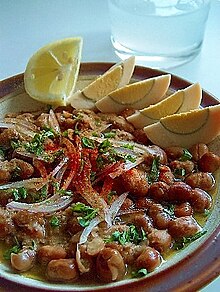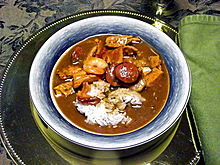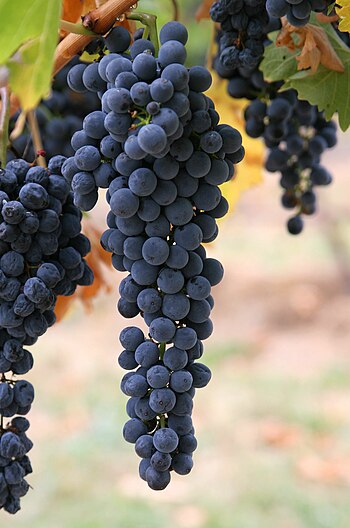F o o d
A portal dedicated to food and foodways
Introduction


Food is any substance consumed by an organism for nutritional support. Food is usually of plant, animal, or fungal origin and contains essential nutrients such as carbohydrates, fats, proteins, vitamins, or minerals. The substance is ingested by an organism and assimilated by the organism's cells to provide energy, maintain life, or stimulate growth. Different species of animals have different feeding behaviours that satisfy the needs of their metabolisms and have evolved to fill a specific ecological niche within specific geographical contexts.
Omnivorous humans are highly adaptable and have adapted to obtain food in many different ecosystems. Humans generally use cooking to prepare food for consumption. The majority of the food energy required is supplied by the industrial food industry, which produces food through intensive agriculture and distributes it through complex food processing and food distribution systems. This system of conventional agriculture relies heavily on fossil fuels, which means that the food and agricultural systems are one of the major contributors to climate change, accounting for as much as 37% of total greenhouse gas emissions. (Full article...)
Cooking, also known as cookery or professionally as the culinary arts, is the art, science and craft of using heat to make food more palatable, digestible, nutritious, or safe. Cooking techniques and ingredients vary widely, from grilling food over an open fire, to using electric stoves, to baking in various types of ovens, reflecting local conditions.
Preparing food with heat or fire is an activity unique to humans. Archeological evidence of cooking fires from at least 300,000 years ago exists, but some estimate that humans started cooking up to 2 million years ago.
The expansion of agriculture, commerce, trade, and transportation between civilizations in different regions offered cooks many new ingredients. New inventions and technologies, such as the invention of pottery for holding and boiling of water, expanded cooking techniques. Some modern cooks apply advanced scientific techniques to food preparation to further enhance the flavor of the dish served. (Full article...)
El Celler de Can Roca is a restaurant in Girona, Catalonia, Spain opened in 1986 by the Roca brothers, Joan, Josep and Jordi. It was first located next to their parents' restaurant Can Roca, but moved to its current purpose-built building in 2007. It has been received warmly by critics, and holds three Michelin stars. El Celler de Can Roca was ranked the best restaurant in the world by the magazine Restaurant in 2013 and 2015, and was ranked second in 2011, 2012, 2014, and 2018. (Full article...)
Selected article –

Selected cuisine -

Lao cuisine or Laotian cuisine is the national cuisine of Laos.
The staple food of the Lao is sticky rice (Lao: ເຂົ້າໜຽວ, khao niao, pronounced [kʰȁw.nǐa̯w]). Laos has the highest sticky rice consumption per-capita in the world with an average of 171 kilograms (377 lb) of sticky rice consumed annually per person. Sticky rice is deeply ingrained in the culture, religious tradition and national identity of Laos. It is a common belief within the Lao community that no matter where they are in the world, sticky rice will always be the glue that holds the Lao communities together, connecting them to their culture and to Laos. Affinity for sticky rice is considered the essence of what it means to be Lao. Often the Lao will refer to themselves as luk khao niaow (Lao: ລູກເຂົ້າໜຽວ, pronounced [luːk kʰȁw.nǐaw]), which can be translated as 'children or descendants of sticky rice'. (Full article...)Selected ingredient –
Lard is a semi-solid white fat product obtained by rendering the fatty tissue of a pig. It is distinguished from tallow, a similar product derived from fat of cattle or sheep.
Lard can be rendered by steaming, boiling, or dry heat. The culinary qualities of lard vary somewhat depending on the origin and processing method; if properly rendered, it may be nearly odorless and tasteless. It has a high saturated fatty acid content and no trans fat. At retail, refined lard is usually sold as paper-wrapped blocks. (Full article...)
Selected recipe –
Kimchi (/ˈkɪmtʃiː/; Korean: 김치, romanized: gimchi, IPA: [kim.tɕʰi]) is a traditional Korean side dish (banchan) consisting of salted and fermented vegetables, most often napa cabbage or Korean radish. A wide selection of seasonings are used, including gochugaru (Korean chili powder), spring onions, garlic, ginger, and jeotgal (a salted seafood). Kimchi is also used in a variety of soups and stews. Kimchi is a staple food in Korean cuisine and is eaten as a side dish with almost every Korean meal.
There are hundreds of different types of kimchi made with different vegetables as the main ingredients. Traditionally, winter kimchi, called kimjang, was stored in large earthenware fermentation vessels, called onggi, in the ground to prevent freezing during the winter months and to keep it cool enough to slow down the fermentation process during summer months. The vessels are also kept outdoors in special terraces called jangdokdae. In contemporary times, household kimchi refrigerators are more commonly used. (Full article...)
Gumbo (Louisiana Creole: Gum-bo) is a stew that is popular in the U.S. state of Louisiana, and is the official state cuisine. Gumbo consists primarily of a strongly flavored stock, meat or shellfish (or sometimes both), a thickener, and the Creole "holy trinity" – celery, bell peppers, and onions. Gumbo is often categorized by the type of thickener used, whether okra or filé powder (dried and ground sassafras leaves).
Gumbo can be made with or without okra or filé powder. The preferred method in the historical New Orleans variation is with a French dark, even chocolate-like, roux. The flavor of the dish has its origins in many cultures. Creole gumbo generally contains shellfish, and a dark roux, filé, or both. Cajun gumbo is generally based on a dark roux and is made with shellfish or fowl. Sausage or ham is often added to gumbos of either variety. After the base is prepared, vegetables are cooked down, and then meat is added. The dish simmers for a minimum of three hours, with shellfish and some spices added near the end. If desired, filé powder is added after the pot is removed from heat. Gumbo is traditionally served with rice. A third, lesser-known variety, the meatless gumbo z'herbes, is essentially a gumbo of slow-cooked greens. (Full article...)Selected image –
Selected biography –
B. February 2, 1948
Ina Rosenberg Garten (/ˈaɪnə/ EYE-nə; born February 2, 1948) is an American television cook and author. She is host of the Food Network program Barefoot Contessa, and was a former staff member of the Office of Management and Budget.
Among her dishes are Perfect Roast Chicken, Weeknight Bolognese, French Apple Tart, and a simplified version of beef bourguignon. Her culinary career began with her gourmet food store, Barefoot Contessa; Garten then expanded her activities to many best-selling cookbooks, magazine columns, and a popular Food Network television show. (Full article...)
Did you know (auto-generated) –

- ... that agronomist Simon Groot was awarded the 2019 World Food Prize for "benefiting hundreds of millions of consumers with greater access to nutritious vegetables"?
- ... that a two-year-old food bank contributed 150 semi-trucks of supplies to relief efforts for Hurricane Katrina?
- ... that not all military rations are food?
- ... that the Cantonese cooking channel Made With Lau began generating about US$50,000 per month in YouTube advertising revenue in under a year?
- ... that New Zealand editor and journalist Madeleine Chapman, known for fashion label exposés and snack food ranking lists, is a champion javelin thrower?
- ... that food critic Grace Dent reviewed a Liverpool restaurant that served her rice pudding flavoured with a substance that is banned in the United States for its lethality?
More did you know –
Related portals
Food topics
The following are topics relating to food
Categories
Food list articles
- See also: Lists of foods and Category:Lists of drinks
The following are some Food list articles on Wikipedia:

- American cheeses
- Appellation d'Origine Contrôlée cheeses
- Apple cultivars
- Bacon dishes
- Bacon substitutes
- Basil cultivars
- Breads
- Breakfast beverages
- Breakfast cereals
- Breakfast foods
- British cheeses
- Cakes
- Candies
- Cheeses
- Cheese soups
- Christmas dishes (list)
- Cocktails
- Cookies
- Dishes using coconut milk
- Diets
- Doughnut varieties
- Egg dishes
- Fermented soy products
- Food additives
- Food additives (Codex Alimentarius)
- Foods named after people
- French cheeses
- French dishes
- Fried dough foods
- Fruits
- List of hamburgers
- Herbs and spices
- Hors d'oeuvre
- Indian dishes
- Indian snack foods
- Indonesian dishes
- Italian dishes
- Japanese snacks
- Japanese dishes
- Jewish dishes
- Kebabs
- Korean beverages
- Mango cultivars
- Moroccan dishes
- Pasta
- Pastries
- Philippine snack food
- Pies, tarts and flans
- Poppy seed pastries and dishes
- Potato dishes
- Puddings
- Raw fish dishes
- Rice dishes
- Rolled foods
- Sauces
- Seafood
- Seeds
- Sandwiches
- Snack foods
- Soft drinks by country
- Soul foods and dishes
- Soups
- Stews
- Street foods
- Tapas
- Turkish dishes
- Twice-baked foods
- Vegetable oils
- Vegetables
- Vodkas
Things you can do
Related WikiProjects
| Parent project: WikiProject Food and Drink | |
| Child projects: | Task forces: (All inactive) |
|
|
| Related projects: | |
New articles
Rules | Match log | Results page (for watching) | Last updated: 2024-04-30 19:18 (UTC)
Note: The list display can now be customized by each user. See List display personalization for details.
- Koffi (restaurant) (edit | talk | history | links | watch | logs | tools) by Another Believer (talk · contribs · new pages (158)) started on 2024-04-30, score: 10
- H. Avard Loomer (edit | talk | history | links | watch | logs | tools) by B3251 (talk · contribs · new pages (29)) started on 2024-04-30, score: 10
- Sherman's Deli & Bakery (edit | talk | history | links | watch | logs | tools) by Another Believer (talk · contribs · new pages (158)) started on 2024-04-30, score: 10
- Paul B. Wishart (edit | talk | history | links | watch | logs | tools) by Dmarsch (talk · contribs · new pages (5)) started on 2024-04-29, score: 10
- Meat water holding capacity (edit | talk | history | links | watch | logs | tools) by GobsPint (talk · contribs · new pages (140)) started on 2024-04-29, score: 10
- Meat diaper (edit | talk | history | links | watch | logs | tools) by GobsPint (talk · contribs · new pages (140)) started on 2024-04-29, score: 20
- Localis (restaurant) (edit | talk | history | links | watch | logs | tools) by Another Believer (talk · contribs · new pages (158)) started on 2024-04-29, score: 10
- Waxi's (edit | talk | history | links | watch | logs | tools) by Jacobo Marcus Galicia (talk · contribs · new pages (1)) started on 2024-04-25, score: 10
- Westman's Bagel & Coffee (edit | talk | history | links | watch | logs | tools) by Another Believer (talk · contribs · new pages (158)) started on 2024-04-19, score: 10
- Kōki Saitō (edit | talk | history | links | watch | logs | tools) by Cynikles (talk · contribs · new pages (1)) started on 2024-04-29, score: 10
- 24 in 24: Last Chef Standing (edit | talk | history | links | watch | logs | tools) by TristanQuinn (talk · contribs · new pages (2)) started on 2024-04-29, score: 10
- La Mejor Bakery (edit | talk | history | links | watch | logs | tools) by BaduFerreira (talk · contribs · new pages (10)) started on 2024-04-29, score: 20
- Wilson Davis (edit | talk | history | links | watch | logs | tools) by Vycl1994 (talk · contribs · new pages (18)) started on 2024-04-28, score: 10
- Sweet Rose Creamery (edit | talk | history | links | watch | logs | tools) by TrademarkedTWOrantula (talk · contribs · new pages (5)) started on 2024-04-28, score: 10
- Hunters Palm Springs (edit | talk | history | links | watch | logs | tools) by Another Believer (talk · contribs · new pages (158)) started on 2024-04-28, score: 10
- Haitian spaghetti (edit | talk | history | links | watch | logs | tools) by Valereee (talk · contribs · new pages (8)) started on 2024-04-27, score: 10
- Artocarpus styracifolius (edit | talk | history | links | watch | logs | tools) by Ulathijau (talk · contribs · new pages (2)) started on 2024-04-27, score: 10
- Atomo (edit | talk | history | links | watch | logs | tools) by White 720 (talk · contribs · new pages (2)) started on 2024-04-27, score: 30
- Lauren Rudolph E. coli case (edit | talk | history | links | watch | logs | tools) by Margaretdonnelly (talk · contribs · new pages (1)) started on 2024-04-23, score: 10
- Ruditapes philippinarum (edit | talk | history | links | watch | logs | tools) by Sjl197 (talk · contribs · new pages (1)) started on 2024-04-27, score: 10
- Bonèt (edit | talk | history | links | watch | logs | tools) by Frankserafini87 (talk · contribs · new pages (3)) started on 2024-04-26, score: 20
- Ganmianpi (edit | talk | history | links | watch | logs | tools) by Iuliusnanus (talk · contribs · new pages (8)) started on 2024-04-25, score: 10
- D'Ambrosio Gelato (edit | talk | history | links | watch | logs | tools) by Another Believer (talk · contribs · new pages (158)) started on 2024-04-25, score: 10
- Murcian meat pie (edit | talk | history | links | watch | logs | tools) by ChampClancy (talk · contribs · new pages (1)) started on 2024-04-24, score: 20
- Full Tilt Ice Cream (edit | talk | history | links | watch | logs | tools) by Another Believer (talk · contribs · new pages (158)) started on 2024-04-24, score: 10
- Roger Hugo (edit | talk | history | links | watch | logs | tools) by NouveauSarfas (talk · contribs · new pages (1)) started on 2024-04-24, score: 10
- Gelatiamo (edit | talk | history | links | watch | logs | tools) by Another Believer (talk · contribs · new pages (158)) started on 2024-04-24, score: 10
- Paratrophis banksii (edit | talk | history | links | watch | logs | tools) by Tom Radulovich (talk · contribs · new pages (155)) started on 2024-04-23, score: 10
- Dumb bread (edit | talk | history | links | watch | logs | tools) by LittleT889 (talk · contribs · new pages (12)) started on 2024-04-23, score: 10
- Frankie & Jo's (edit | talk | history | links | watch | logs | tools) by Another Believer (talk · contribs · new pages (158)) started on 2024-04-23, score: 10
- List of food and drink monuments (edit | talk | history | links | watch | logs | tools) by Altenmann (talk · contribs · new pages (77)) started on 2024-04-23, score: 20
- Ko Omm (edit | talk | history | links | watch | logs | tools) by Sattwaikyaw (talk · contribs · new pages (1)) started on 2024-04-22, score: 10
- Nourishing Hope (edit | talk | history | links | watch | logs | tools) by Raearutherford (talk · contribs · new pages (1)) started on 2024-04-16, score: 10
- Rachel's Ginger Beer (edit | talk | history | links | watch | logs | tools) by Another Believer (talk · contribs · new pages (158)) started on 2024-04-22, score: 10
- Crisp pork (edit | talk | history | links | watch | logs | tools) by チャリス (talk · contribs · new pages (8)) started on 2024-04-22, score: 20
- "Flower" tofu (edit | talk | history | links | watch | logs | tools) by チャリス (talk · contribs · new pages (8)) started on 2024-04-22, score: 10
- Taro pastry (edit | talk | history | links | watch | logs | tools) by Heeheemalu (talk · contribs · new pages (14)) started on 2024-04-22, score: 10
- Garbage Plate (edit | talk | history | links | watch | logs | tools) by BanjoZebra (talk · contribs · new pages (5)) started on 2024-04-10, score: 40
- Morning in America (EP) (edit | talk | history | links | watch | logs | tools) by OttoJohn (talk · contribs · new pages (1)) started on 2024-04-21, score: 10
- Mike's Hot Honey (edit | talk | history | links | watch | logs | tools) by BanjoZebra (talk · contribs · new pages (5)) started on 2024-04-21, score: 40
- Zajiangmian (edit | talk | history | links | watch | logs | tools) by チャリス (talk · contribs · new pages (8)) started on 2024-04-21, score: 20
- Cannabis in the restaurant industry (edit | talk | history | links | watch | logs | tools) by Another Believer (talk · contribs · new pages (158)) started on 2024-04-21, score: 10
- Kentrell Barkley (edit | talk | history | links | watch | logs | tools) by Skyggestadium (talk · contribs · new pages (7)) started on 2024-04-21, score: 10
- Coffee Talk Episode 2: Hibiscus & Butterfly (edit | talk | history | links | watch | logs | tools) by JuniperChill (talk · contribs · new pages (12)) started on 2024-04-20, score: 20
- Dough Joy (edit | talk | history | links | watch | logs | tools) by Another Believer (talk · contribs · new pages (158)) started on 2024-04-20, score: 20
- Chicken galantina (edit | talk | history | links | watch | logs | tools) by Obsidian Soul (talk · contribs · new pages (36)) started on 2024-04-19, score: 20
- Ponche Navideño (edit | talk | history | links | watch | logs | tools) by Valereee (talk · contribs · new pages (8)) started on 2024-04-19, score: 20
- Lengua estofado (edit | talk | history | links | watch | logs | tools) by Obsidian Soul (talk · contribs · new pages (36)) started on 2024-04-19, score: 20
- PDX671 (edit | talk | history | links | watch | logs | tools) by Another Believer (talk · contribs · new pages (158)) started on 2024-04-19, score: 10
- Organic market in Ukraine (edit | talk | history | links | watch | logs | tools) by QFTP2024 (talk · contribs · new pages (1)) started on 2024-04-16, score: 10
- Taqua banana (edit | talk | history | links | watch | logs | tools) by Fredo.fernando (talk · contribs · new pages (1)) started on 2024-04-18, score: 10
- Butifarra (sandwich) (edit | talk | history | links | watch | logs | tools) by Tony24644 (talk · contribs · new pages (6)) started on 2024-04-18, score: 10
- Kuai Kuai (edit | talk | history | links | watch | logs | tools) by Heeheemalu (talk · contribs · new pages (14)) started on 2024-04-17, score: 20
- Rocklands Barbeque and Grilling Company (edit | talk | history | links | watch | logs | tools) by DarkNight0917 (talk · contribs · new pages (7)) started on 2024-04-17, score: 10
- Sweet Alchemy (edit | talk | history | links | watch | logs | tools) by Another Believer (talk · contribs · new pages (158)) started on 2024-04-16, score: 10
- Diet Coke (edit | talk | history | links | watch | logs | tools) by 99.196.135.213 (talk · contribs · new pages (1)) started on 2024-04-16, score: 20
- The Lakes Distillery (edit | talk | history | links | watch | logs | tools) by ChefBear01 (talk · contribs · new pages (5)) started on 2024-04-16, score: 20
- Cully & Sully (edit | talk | history | links | watch | logs | tools) by Liz (talk · contribs · new pages (88)) started on 2024-04-16, score: 30
- Trine Lotherington Danielsen (edit | talk | history | links | watch | logs | tools) by Geschichte (talk · contribs · new pages (24)) started on 2024-04-16, score: 10
- Medical Device User Fee and Modernization Act (edit | talk | history | links | watch | logs | tools) by GobsPint (talk · contribs · new pages (140)) started on 2024-04-16, score: 10
- Uneeda Biscuit (edit | talk | history | links | watch | logs | tools) by CNMall41 (talk · contribs · new pages (21)) started on 2024-04-10, score: 30
Associated Wikimedia
The following Wikimedia Foundation sister projects provide more on this subject:
-
 Commons
Commons
Free media repository -
 Wikibooks
Wikibooks
Free textbooks and manuals -
 Wikidata
Wikidata
Free knowledge base -
 Wikinews
Wikinews
Free-content news -
 Wikiquote
Wikiquote
Collection of quotations -
 Wikisource
Wikisource
Free-content library -
 Wikiversity
Wikiversity
Free learning tools -
 Wiktionary
Wiktionary
Dictionary and thesaurus








































